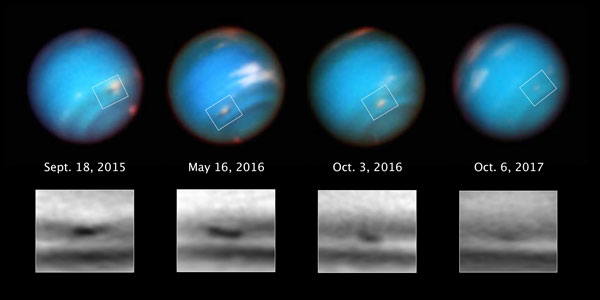Hubble's powerful eye scouts the outer planets once an Earth year, shedding light on giant planet atmospheres.
Storms in the outer solar system have researchers puzzled — and Hubble is here to help.
Jupiter's Great Red Spot has been shrinking for decades — yet it’s getting slightly taller even as its reduces in width, a new study revealed Tuesday. The storm’s shape change might also affect its increasingly orange color. And last month, NASA released images of a large storm on Neptune that’s shrinking instead of falling apart; researchers previously thought the storm would dissipate as it moved towards the planet’s equator.

NASA, ESA, and M.H. Wong and A.I. Hsu (UC Berkeley)
These results, which both appear in The Astronomical Journal (Jupiter paper, Neptune paper), are the latest from the Hubble Space Telescope's Outer Planet Atmospheres Legacy (OPAL) program, which has NASA’s most popular telescope examine each of the outer planets (Jupiter, Saturn, Uranus and Neptune) at least once an Earth year to look for changes in their atmospheres.
OPAL Observations
The OPAL program arose from a white paper issued about five years ago, which argued for an outer planet monitoring system. Before the space age, the researchers wrote, meteorologists understood the basic physics of fluid flow on Earth. But it took advances in weather monitoring –weather stations spread over the globe and, later, satellites – to improve scientific understanding of our planet's atmosphere.
In turn, scattered observations of the outer planets had already showed changes in their atmospheres both over short time periods of weeks or months as well as over an entire planet's year (the time it takes to orbit the Sun). And they also showed how local disturbances can have global effects: Changing wind patterns and cloud structures at Jupiter, for example, affect everything from its famous Great Red Spot to the structure of hazes in its atmosphere, the researchers say.
The general plan was for Hubble to map each planet when it’s at opposition, roughly once an Earth year. By taking snapshots once a Hubble orbit — that is, every 90 minutes — researchers could chart both hemispheres (west and east) of each planet annually.
Granted, annual observations make it difficult to figure out what’s going on. "It's like looking at Earth every few months and trying to understand the weather," says Amy Simon (NASA Goddard), a senior scientist for planetary atmospheres research who led the white paper. Still, Hubble is an immensely popular telescope with many demands on its time, and scientists are pleased with observations they’ve obtained so far.
Early Results
Hubble started the OPAL program in 2014, and results are already stacking up.
At Jupiter, the researchers recently determined its shrinking Great Red Spot is getting more intense in color, possibly because the chemicals that give the storm its color are moving higher up in the atmosphere.
Surprisingly, the storm also appears to be getting taller. Researchers previously thought that the contracting storm would host stronger winds, like an ice skater who spins faster by pulling their arms inward. Instead, however, the storm is expanding in height. “It’s almost like clay being shaped on a potter’s wheel,” NASA stated in a press release. “As the wheel spins, an artist can transform a short, round lump into a tall, thin vase by pushing inward with his hands. The smaller he makes the base, the taller the vessel will grow.”.
At Neptune, OPAL’s biggest discovery so far has been a new “great dark spot,” like the one discovered by Voyager 2 during its 1989 flyby. The storm is invisible to other ground-based observatories looking at the planet. “Only Hubble could see it in that blue wavelength,” Simon explains.
Researchers are also examining Neptune’s reflected sunlight using OPAL, as well as the ground-based Keck Observatory. Neptune’s reflectivity changes, and researchers wanted to know why. “The thing we found – what really overwhelms your signals – is the cloud changes,” Simon says. The day-to-day changes in cloud coverage affect how much sunlight Neptune reflects, which in turn affects what kind of signal it would give as it orbits the Sun.
“It turns out that’s really useful for the brown dwarf community,” Simon adds. This data will improve the models for researchers searching for brown dwarfs using data from the Kepler space telescope.
Observations from amateur astronomers help expand OPAL’s reach. For example, combining Hubble’s data with amateur observations, OPAL detected waves in Jupiter's north equatorial belt that had not been seen since the Voyager 2 spacecraft flew by Jupiter in 1979, Simon says.
Simon says amateur observations have also been key to observing Uranus, because its storms often dissipate in only minutes or hours. “You need to be looking pretty quickly,” she says. “There's been one [storm] that has been persistent from year to year, but the other stuff gets sheared apart really fast.”
OPAL is expected to continue until the end of Hubble's lifetime late in the 2020s. The team will also perform observations with the James Webb Space Telescope (JWST), which should launch next year.
“We have some guaranteed time [on JWST],” Simon says. “What we'd like to do is have a fair amount of overlap time between the telescopes, with high-resolution data from Webb in the infrared, and some spectroscopy." The researchers will test their observations first on Jupiter, then propose plans for the other planets.
 0
0









Comments
You must be logged in to post a comment.